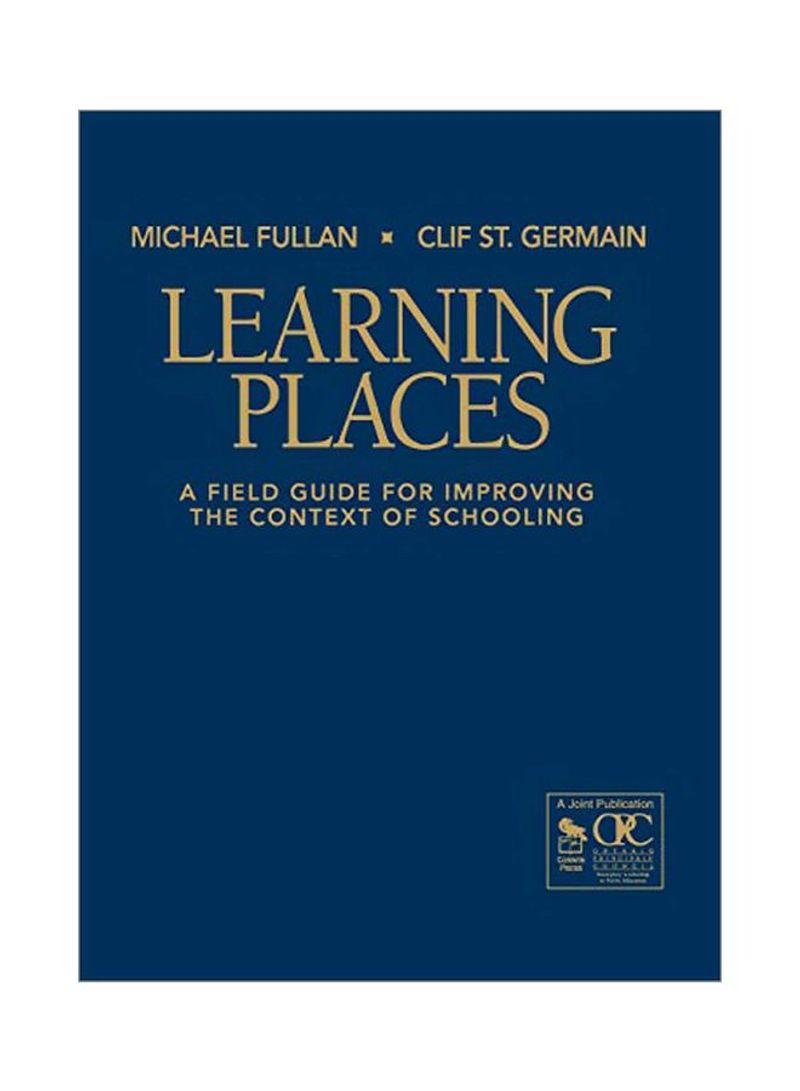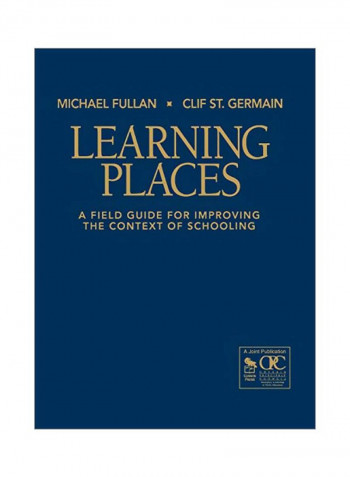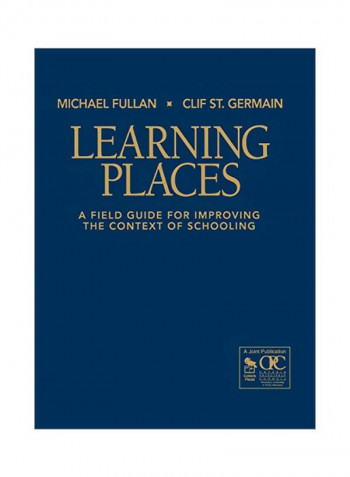Learning Places: A Field Guide For Improving The Context Of Schooling Hardcover
Recommend
Sort by
Rating
Date
Specifications
Author 1
Michael Fullan
Book Description
This timely book is exactly what modern schools need, blending Fullan's theoretical genius about change with practical strategies that can work in any school. Readers will discover that it is practical, easy to use, and empowering for educators, with lots of room for personal choices at the school level' - Lyn Sharratt, Superintendent of Curriculum and Instructional Services, York Region District School Board, North Toronto, ON, Canada 'This book is an easy read and provides a well developed idea of framing the school context for student achievement. The author provides excellent resources, worksheets, templates, walk-through and reflection ideas, and additional support materials' - Rosemarie Young, Past President, National Association of Elementary School Principals, USA Need an inspiring approach to school change? Need staying power for school improvement initiatives? Organized to make learning contagious throughout the school, this user-friendly guide helps create a culture of learning that promotes the simultaneous development of students, teachers, and parents - addressing specific ways to maximize study groups, student data, classroom walk-throughs, and more. The interactive self-assessment procedures focus on: o achieving a sense of purpose o facilitating program coherence o invigorating classroom teaching o supporting the professional development of teachers o developing wider circles of leadership Issuing a call to action for all educational communities, this easy-to-use manual offers a visionary yet grounded approach to revitalize educators and reenergize their efforts for meaningful, lasting reform.
ISBN-13
9781412942324
Language
English
Publisher
SAGE Publications Inc
Publication Date
12 Sep 2006
Number of Pages
224
About the Author
Michael Fullan, OC, is the former Dean of the Ontario Institute for Studies in Education and Professor Emeritus of the University of Toronto. He is co-leader of the New Pedagogies for Deep Learning global initiative. Recognized as a worldwide authority on educational reform, he advises policymakers and local leaders in helping to achieve the moral purpose of all children learning. Michael Fullan received the Order of Canada in December 2012. He holds honorary doctorates from several universities around the world. Fullan is a prolific, award-winning author whose books have been published in many languages. His book Leading in a Culture of Change received the 2002 Book of the Year Award by Learning Forward. Breakthrough (with Peter Hill and Carmel Crevola) won the 2006 Book of the Year Award from the American Association of Colleges for Teacher Education (AACTE), and Turnaround Leadership in Higher Education (with Geoff Scott) won the Bellwether Book Award in 2009. Change Wars (with Andy Hargreaves) was named the 2009 Book of the Year by Learning Forward, and Professional Capital (with Andy Hargreaves) won the AACTE 2013 Book of the Year and the Grawemeyer Award in Education in 2015. Michael Fullan's latest books are The Principal: Three Keys for Maximizing Impact ; Coherence: The Right Drivers in Action for Schools, Districts, and Systems (with Joanne Quinn); Deep Learning: Engage the Change the World (with Joanne Quinn and Joanne McEachen); Surreal Change: The Real Life of Transforming Public Education (autobiography); and Nuance: Why Some Leaders Succeed and Others Fail. For more information on books, articles, and videos, please go to www.michaelfullan.ca. Some people dream of writing the next great novel, others dream of inventing things. Not me. I dream about good schools-happy, bustling, productive schools. I can't think of anything more beautiful. Nor can I remember a time when I wasn't thinking about better ways to unleash the power of passion and commitment I see in the eyes of good teachers. That's why the opportunity to work with Michael Fullan on this Field Guide is, for me, a dream come true. Michael sees deeply into schools. His work is about creating circumstances that enable schools (and school systems) to initiate and sustain their own development. As I reflect upon my 30 years in schools, especially the 15 years I served as principal of a troubled elementary school, and later a large secondary school, I am reminded of how the circumstances of our daily schedules always seemed to favor a resignation to our present reality. However, in spite of those circumstances, whenever we mustered the courage to set aside our distress (and our dependence on the larger system) and instead made time to talk to each other about improving our teaching, good things happened. By looking deeply at what we were doing, and then taking action on behalf of our students, we found ways to experience the rewards of working with young learners. In my first appointment as principal, parents wanted the school to be a happy place where children were engaged in relevant learning. This simple mission guided instructional decisions and gave purpose to efforts to improve the school environment. Without going through the usual bureaucratic channels, the faculty threw caution to the winds and painted a rainbow on the front of the school whose stucco walls had not been patched or painted for more than a decade. We became known as the "rainbow school," and the rainbow became the school's emblem, a symbol of our many differences joined together to create something beautiful. Long before it was popular we recognized the power of professional development. We applied for and were granted special permission to enact an alternative schedule to extend the teaching day four days a week, curtail the teaching day one day a week, and provide time for teachers to refine the daily routines of the school. During this professional development block, teachers discussed student academic profiles, aligned curriculum to standards, shared best practice teaching strategies and decided upon a future course of action. In sum, we examined every aspect of the school in light of our belief that people learn best in purposeful, validating and happy environments. We also discovered that, when it comes to learning, the paths to success are as varied as the kids. And even though most of our students were predicted to be low performers, their achievement scores showed otherwise. Although the circumstances were quite different in my second assignment as principal, similar priorities guided our actions. This large, comprehensive high school, popularized as an academic magnet, was achieving below acceptable standards. Fighting, class cutting, and student surliness were common occurrences. Once again, our shared set of priorities and our strong conviction to create the best school possible led to solutions. Parents, teachers and students agreed that a rigorous academic program in an environment of collegiality was our goal. Therefore, we were guided by three principles: (1) purposefulness, (2) collegiality, and (3) persistence. We later wrote handbooks, course outlines and standards for excellence in each discipline. We stressed visually pleasing classrooms, honored diversity of thought and rewarded curiosity, divergent thinking and questioning. We also instituted school wide instructional support programs and created art whenever and wherever we could. We even had the audacity to connect a sound system to the public address system and played symphonic music as students changed classes. The success of these two schools and the processes we used to re-invent them are now well documented. The elementary school, part of a longitudinal study over the tenure of five principals, was recognized as a model learning community during a presentation at the American Educational Research Association. The high school was named a "National School of Excellence." The contagious momentum we created in both schools was not extraordinary; it is available to all who have the courage to work for it.
Author 2
Clif St. Germain
Editorial Review
"Presents a workbook-style blend of information about assessment, the change process, differentiated instruction, and other pedagogical approaches with strategies encouraging reflection, conversation, and research among groups of educators. The book is filled with inspirational quotes, thoughtful questions, and challenging directives to further encourage reader reflection." -- PsycCRITIQUES, August 2007, Vol. 52(33) "Presents staff, students, administrators and parents with a road map to a 'grand vision,' and invites us to join the highest of all human enterprises-the creating of a better world, starting with our schools. Provides every school staff the opportunity and tools to create a school engendering and affirming that deepest and most pervasive human drive, the drive to learn." -- Lucianne B. Carmichael, Principal, McDonogh 15 School, New Orleans, LA "Simply and beautifully weds theory and practice! This book should be on all administrators' desks as they go about the critical task of education for young people today. Brings forth the finest in theory and the best in practice and at the same time affirms the values that our society was built on and through which it will thrive." -- Brother Jeffrey L. Calligan, Auxiliary Provincial and Director of Education "This timely book is exactly what modern schools need, blending Fullan's theoretical genius about change with practical strategies that can work in any school. Readers will discover that it is practical, easy to use, and empowering for educators, with lots of room for personal choices at the school level." -- Lyn Sharratt, Superintendent of Curriculum and Instructional Services "Learning Places will help all of us transform schools and their classrooms into cultures hospitable to human learning. I wish I had had this field guide during my own turbulent years as a school principal." -- Roland S. Barth, Author, Lessons Learned "The book is a very easy read-good for busy practitioners. No matter where you are in the process, you can jump in and use the tools." -- Teri White, Principal "It is necessary to keep our eyes on the real work of improving our schools and not be sidetracked into jumping through hoops that are in the end not meaningful. This book provides the reader with that opportunity." -- Nic Cooper, Principal "This book is an easy read and provides a well developed idea of framing the school context for student achievement. The author provides excellent resources, worksheets, templates, walk-through and reflection ideas, and additional support materials." -- Rosemarie Young, Past President show less



